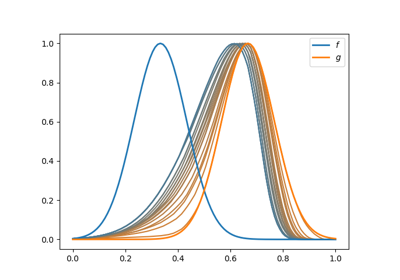invert_warping#
- skfda.preprocessing.registration.invert_warping(warping, *, output_points=None)[source]#
Compute the inverse of a diffeomorphism.
Let \(\gamma : [a,b] \rightarrow [a,b]\) be a function strictly increasing, calculates the corresponding inverse \(\gamma^{-1} : [a,b] \rightarrow [a,b]\) such that \(\gamma^{-1} \circ \gamma = \gamma \circ \gamma^{-1} = \gamma_{id}\).
Uses a PCHIP interpolator to compute approximately the inverse.
- Parameters:
warping (FDataGrid) – Functions to be inverted.
output_points (Optional[ArrayLike]) – Set of points where the functions are interpolated to obtain the inverse, by default uses the sample points of the fdatagrid.
- Returns:
Inverse of the original functions.
- Raises:
ValueError – If the functions are not strictly increasing or are multidimensional.
- Return type:
Examples
>>> import numpy as np >>> from skfda import FDataGrid
We will construct the warping \(\gamma : [0,1] \rightarrow [0,1]\) wich maps t to t^3.
>>> t = np.linspace(0, 1) >>> gamma = FDataGrid(t**3, t) >>> gamma FDataGrid(...)
We will compute the inverse.
>>> inverse = invert_warping(gamma) >>> inverse FDataGrid(...)
The result of the composition should be approximately the identity function .
>>> identity = gamma.compose(inverse) >>> identity([0, 0.25, 0.5, 0.75, 1]).round(3) array([[[ 0. ], [ 0.25], [ 0.5 ], [ 0.75], [ 1. ]]])

